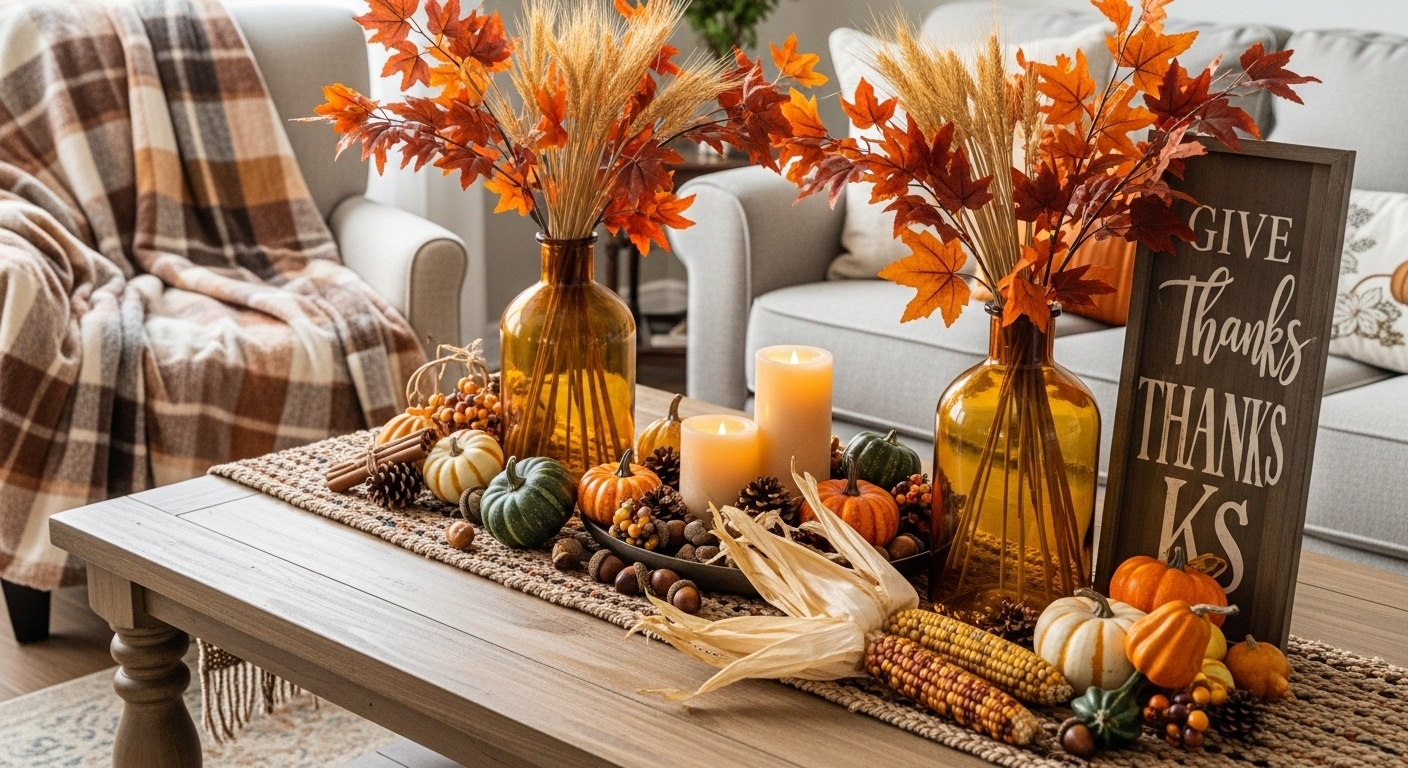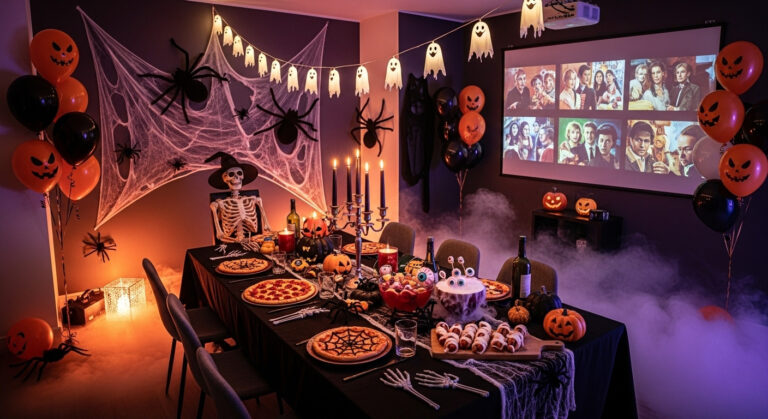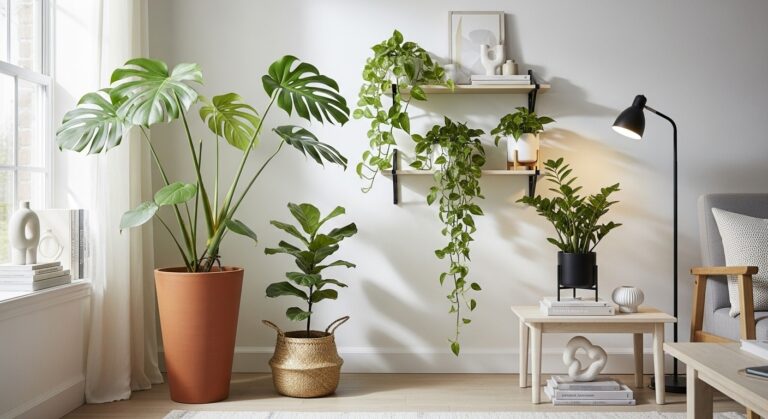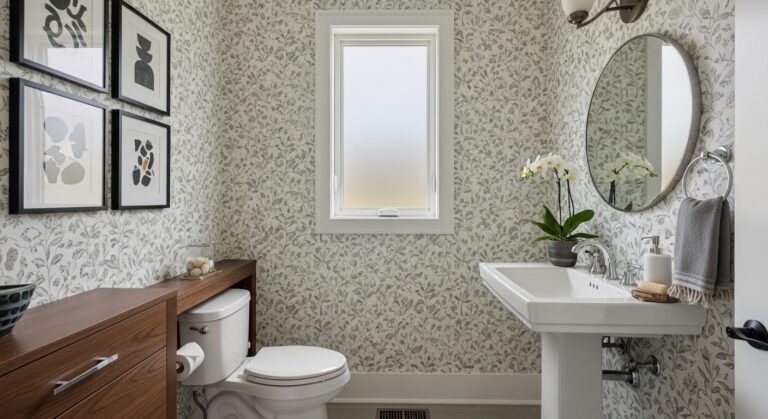Thanksgiving décor works best when it feels warm, generous, and easy to live with. Rather than packing every corner with pumpkins, think in layers: natural materials, a grounded color palette, and a few intentional focal points guests will notice the moment they arrive. Prioritize comfort—clear walkways, eye-level moments, and candlelight that glows without getting in the way of conversation. The ideas below balance style with function, so your home looks welcoming from the front step to the dining table and stays practical once the cooking starts.
Welcome Porch in Harvest Tones
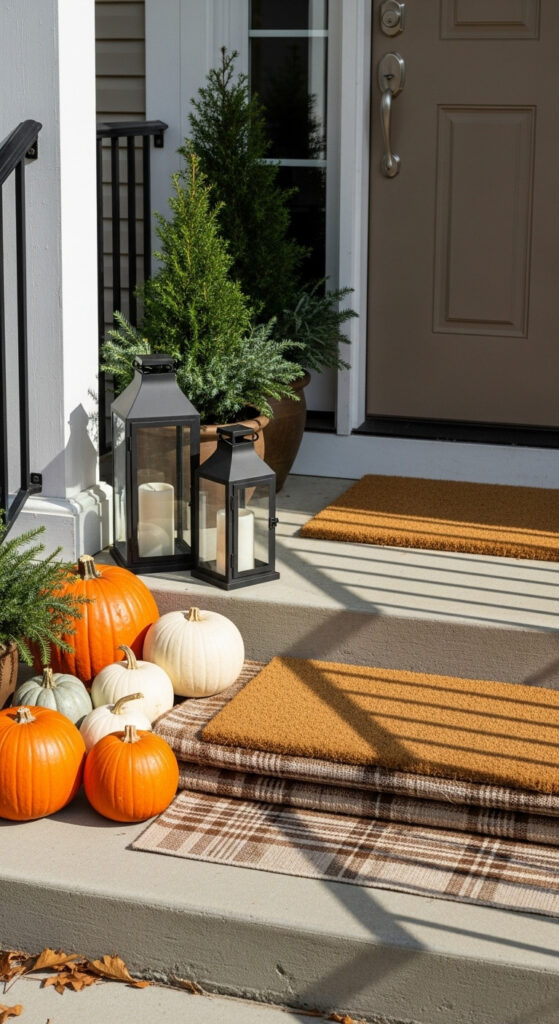
Your porch sets the tone for the whole day. Build a simple arrangement that reads from the sidewalk and still feels fresh up close: a pair of planters filled with clipped evergreen branches and small sugar pumpkins, a dark coir mat layered over a plaid outdoor rug, and two lanterns at different heights near the door. Keep the center of the steps clear for easy footing. If you have a bench, add one folded throw in a deep rust or cinnamon shade. The look is classic, but the restraint keeps it polished—more “seasonal entry” than pop-up farm stand.
Layered Table Runner and Low Centerpiece
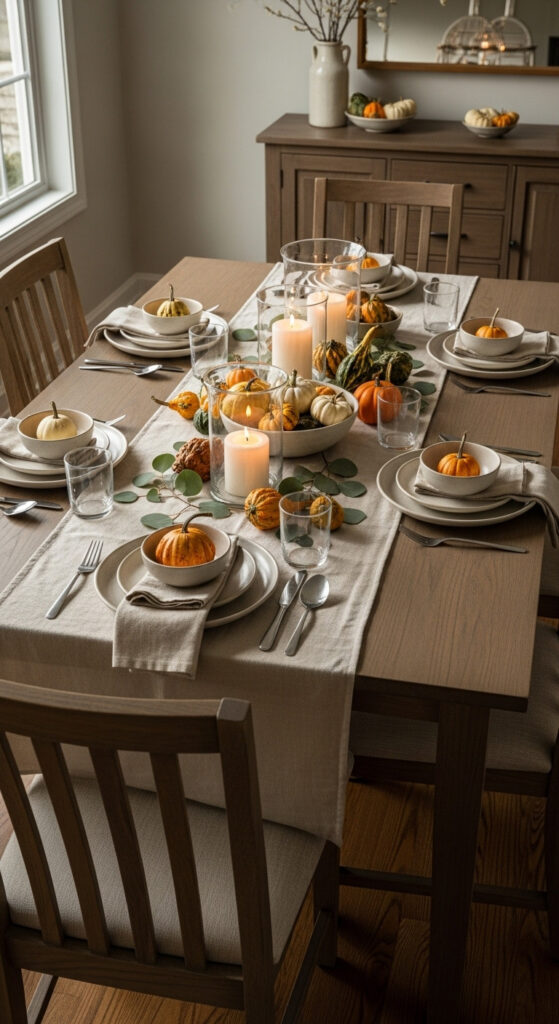
Tall bouquets look dramatic in photos but block eye contact once dinner starts. Build a low, linear centerpiece that lets conversations flow. Start with a textured runner—linen or cotton in oatmeal, caramel, or deep mocha—then cluster low bowls of mixed gourds, a few pillar candles in glass hurricanes, and small sprigs of eucalyptus or bay for fragrance. Keep everything below eight inches. The table will feel abundant without anyone dodging stems. As a bonus, low elements can slide together or apart as platters arrive.
Warm Neutrals with One Accent Color
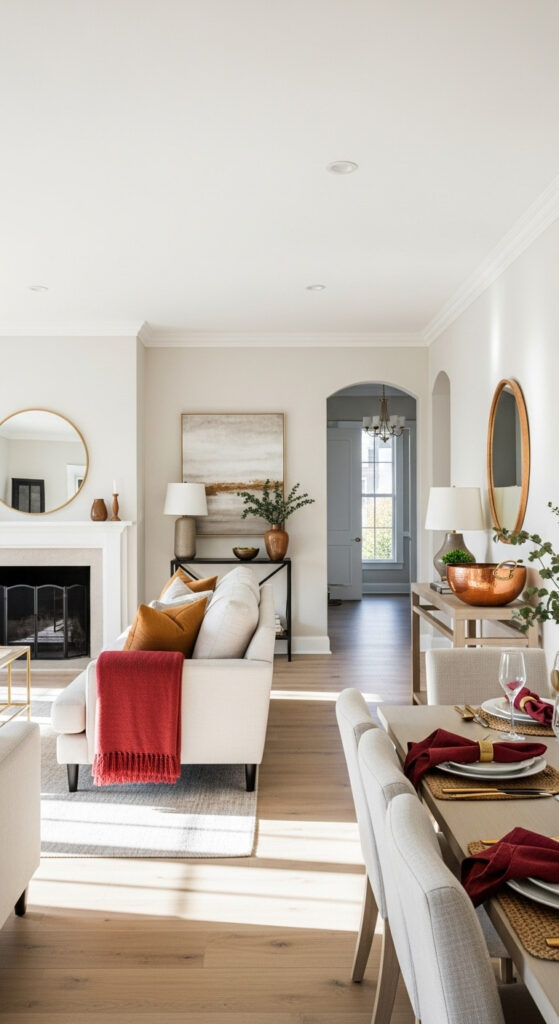
A tight palette keeps your rooms calm even when the house is full. Start with warm neutrals—cream, camel, soft gray—and choose one accent color to repeat in key spots. Deep cranberry feels festive without turning into full holiday red; burnt sienna or copper works beautifully with wood tones. Repeat that accent in napkins, ribbon tails around candlesticks, a ceramic bowl on the console, and a single throw on the sofa. When guests move from entry to living room to table, the spaces will feel connected.
Mixed Candlelight for Depth
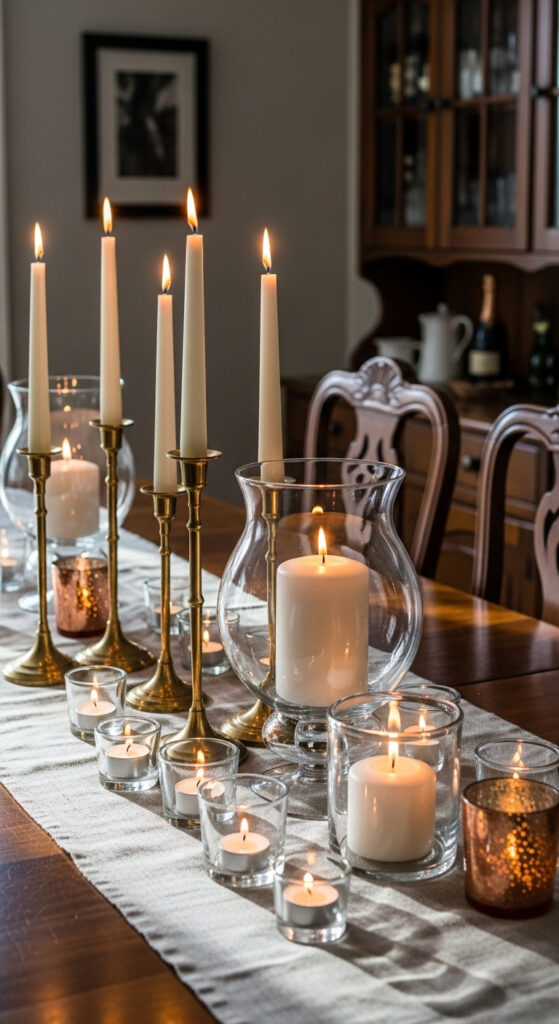
Candlelight does more than set a mood—it hides visual noise and makes textures richer. Mix three types: tapers in sturdy holders for height, pillars in hurricanes for safe glow, and tea lights in heavy glass for sparkle. Keep scents neutral near the table; if you love fragrance, reserve it for the entry. Place candles in clusters of three or five and leave open “landing zones” for platters. You’ll get a layered glow that photographs beautifully and still leaves room for the food to shine.
Branches and Gourds Still Life
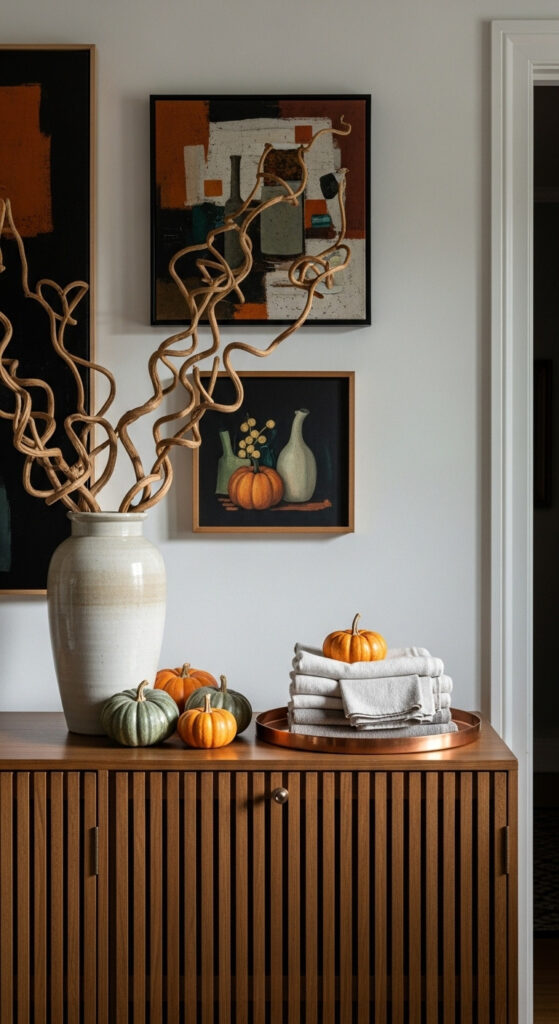
When flowers are pricey or sparse, branches carry the day. Clip a few shapely, leafless branches (or ones with late-season leaves) and stand them in a tall ceramic vase on the sideboard. Ground the vignette with a trio of heirloom gourds, a small copper tray, and a stack of linen towels. The vertical line draws the eye without blocking views, and the materials—ceramic, copper, linen—feel distinctly autumn without shouting. It’s an easy way to bring the season into rooms that aren’t set for dining.
Personalized Place Cards with Herbs and Ribbon
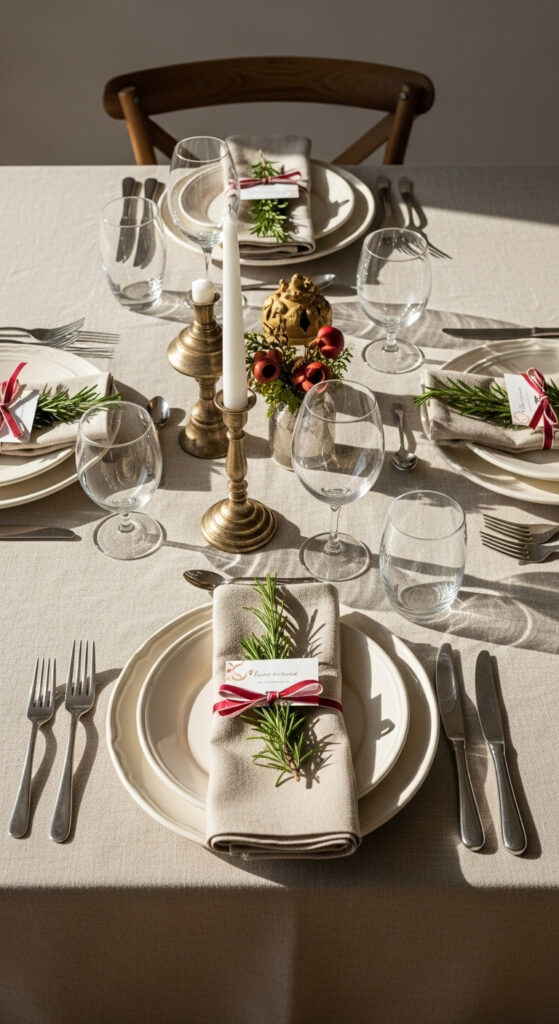
Place cards are small, but they make guests feel seen. Cut thick card stock into simple rectangles, write names in a clean script, and tie each to a sprig of rosemary or bay with a thin velvet or satin ribbon in your accent color. Set cards on the plate or tuck them into napkin rings. The greenery adds a fresh note without crowding the table, and the ribbon quietly repeats your palette. Best of all, it takes minutes and looks like you planned for weeks.
Cozy Mantel with Pumpkins and Copper
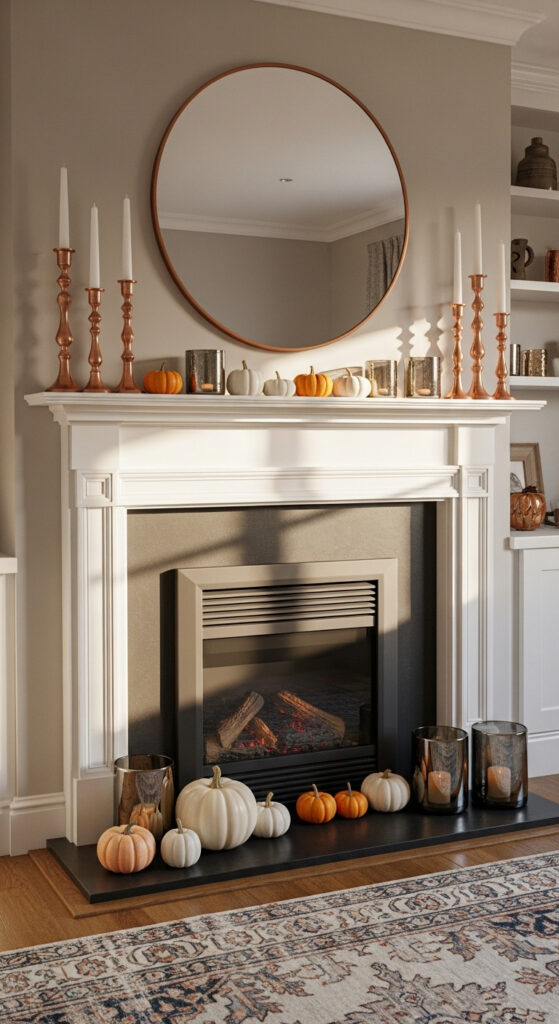
A mantel is the perfect place for a quiet, classy nod to the holiday. Start with a runner of black or deep brown gauze for texture, then line up small white and muted orange pumpkins, mixing in copper candlesticks and a few low votives in smokey glass. Add a pair of framed botanicals or a round mirror above to bounce light back into the room. Keep heights varied but not towering, and leave space between objects so it doesn’t feel crowded.
Entry Console Gratitude Vignette
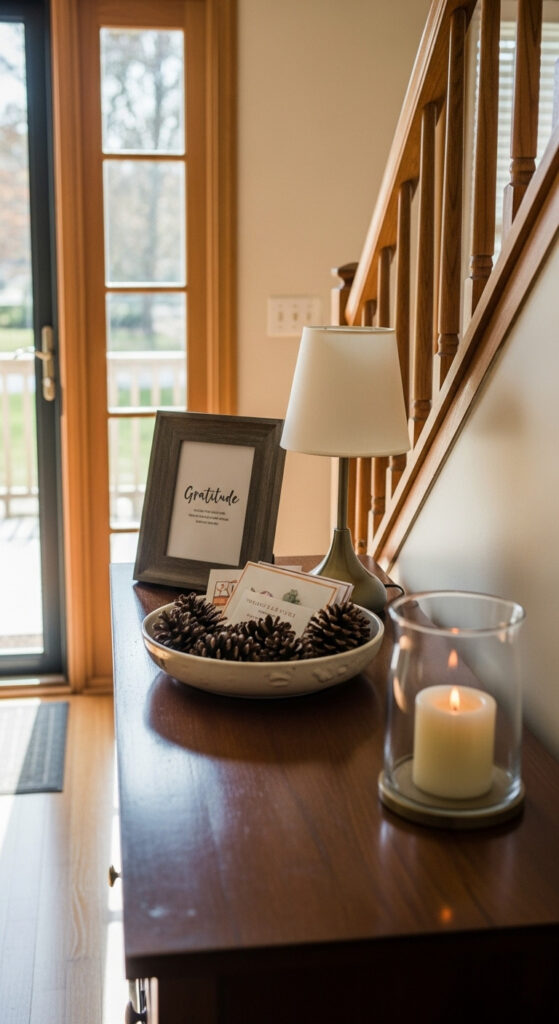
Set a gracious tone as soon as guests step inside. On an entry console, arrange a ceramic bowl filled with pinecones and acorns, a short stack of blank cards with a pen, and a framed prompt that reads, “What are you grateful for this year?” Guests can jot a note and tuck it in the bowl. Add a small lamp for glow and a single taper in a hurricane for height. It’s décor with purpose—quiet, heartfelt, and easy to assemble.
Kitchen Island as Abundant Display
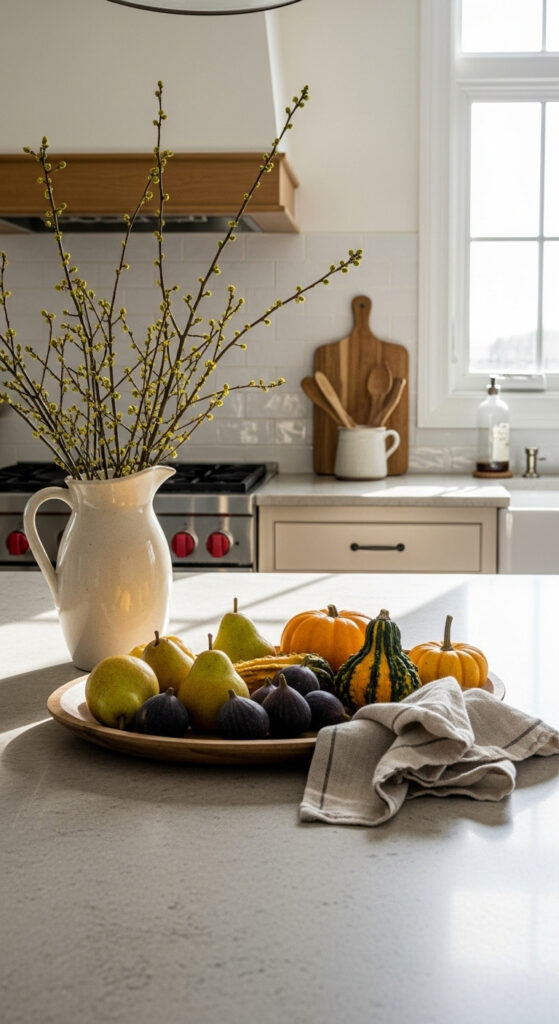
The island is command central on Thanksgiving, so keep décor low, moveable, and truly functional. Place a shallow wooden tray with pears, figs, and small gourds, nestle in a linen towel, and keep a pitcher of branches to one side—far from the workspace. Add a stack of extra napkins and tasting spoons inside the tray so it earns its keep. This small, composed arrangement looks bountiful without stealing prep space when things get busy.
Kids’ Table That Doubles as Decor
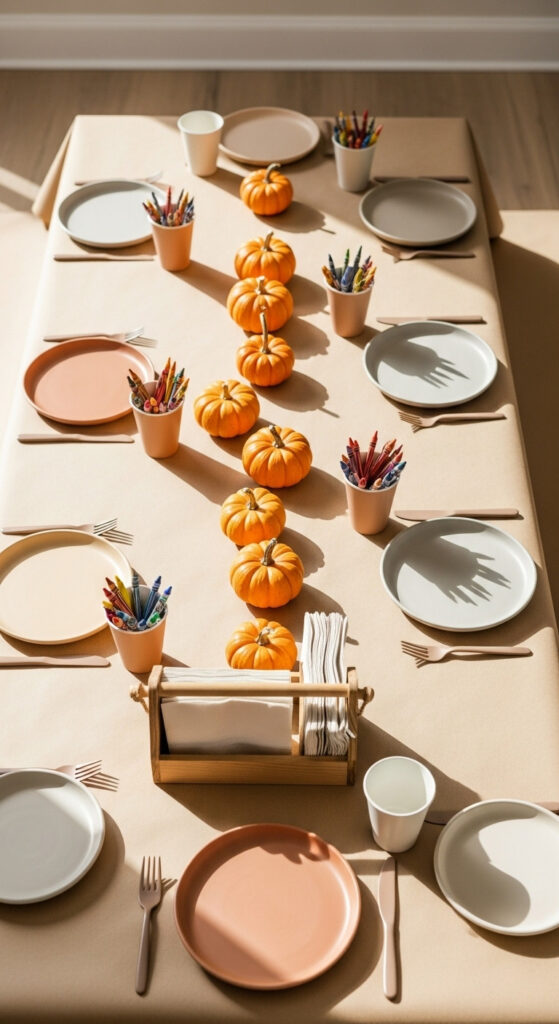
Set the kids up with something charming and mess-friendly. Roll out kraft paper as a table cover, add small cups of crayons, and place a handful of mini pumpkins in the center. Use lightweight, unbreakable plates in a muted color and fill a small caddy with napkins and water cups. The setup looks sweet from a distance, photographs well, and keeps little hands busy while adults plate the meal. When dinner’s over, roll up the paper and the cleanup is done.
Outdoor Lounge with Throws and Lanterns
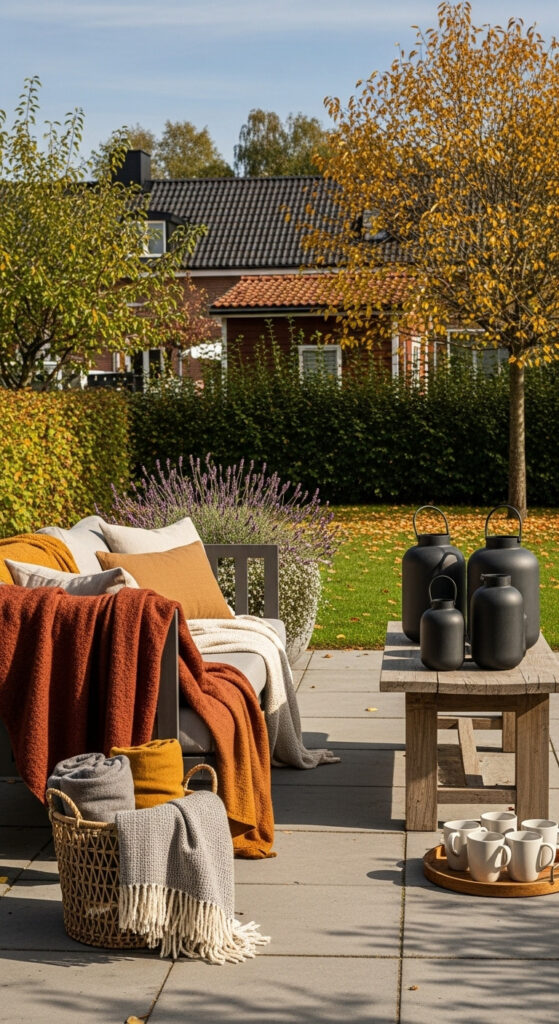
If the weather cooperates, give guests a breath of fresh air. Dress an outdoor bench or sectional with woven throws in russet, cumin, and oatmeal tones, and cluster three lanterns on the coffee table for a cozy glow at dusk. Add a tray with hot cider mugs and keep a small basket of extra blankets nearby. Even ten minutes outside will reset the room’s energy and make the house feel bigger without moving any walls.
Small-Space Sideboard Buffet Styling
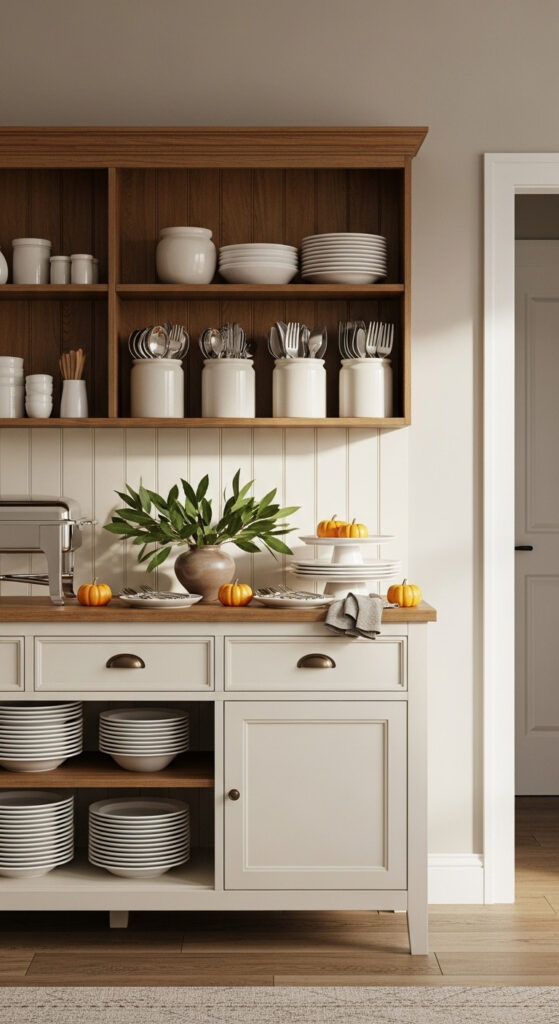
No dining room? No problem. Turn a modest sideboard or even a console into a buffet that looks intentional. Use risers (upside-down bowls, sturdy cookbooks under a towel) to create two levels, set out stacks of plates on the left, and run utensils in small crocks on the right. Slip a few tiny pumpkins and a low vase of bay leaves between serving pieces. The asymmetry feels modern, and the extra height keeps traffic moving.
Bar Cart with Cider Station
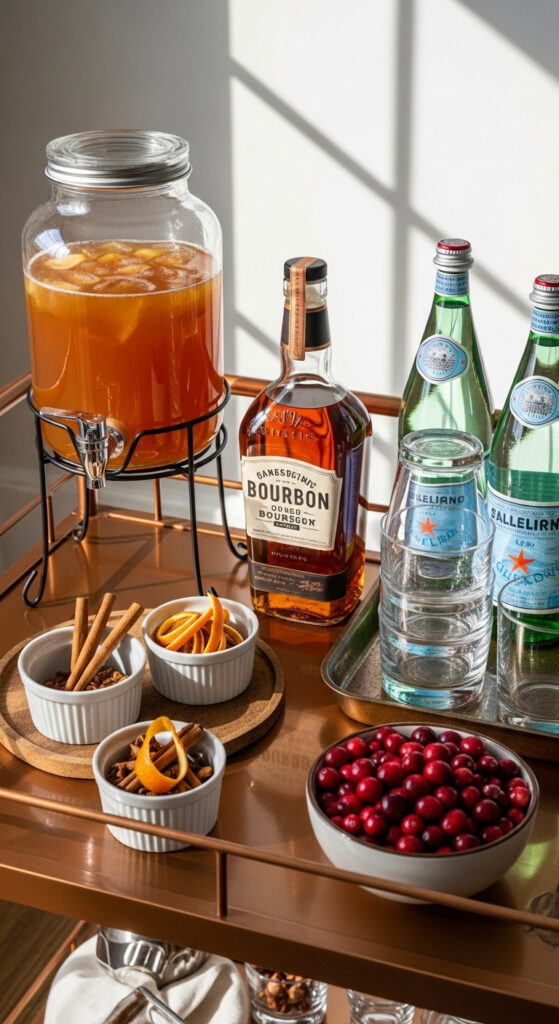
Give your bar cart a seasonal job. Fill a clear dispenser with hot (or room-temp) apple cider, set out cinnamon sticks and orange peel in small ramekins, and offer bourbon or rum on the top shelf with sparkling water below for non-alcoholic mixes. Add a single votive and a bowl of cranberries for color. Label everything with simple tags so guests can help themselves. The cart looks festive, saves you time, and rolls wherever the conversation lands.
Textiles That Pull Rooms Together
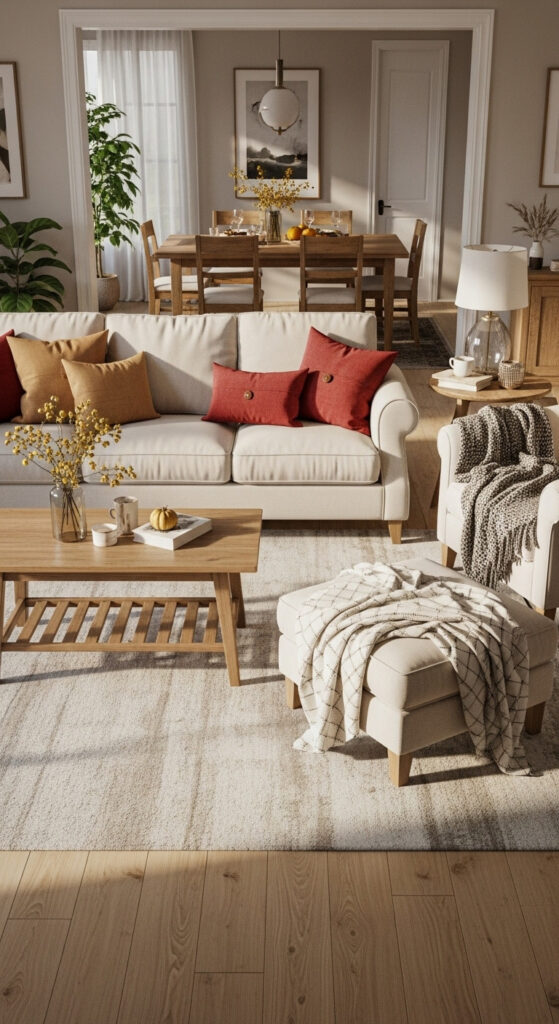
When the meal’s over, everyone drifts to the sofa. Swap in pillow covers and throws that echo your table palette—camel, cream, deep cranberry, or burnt orange—without overwhelming the room. Layer a nubby wool throw over the back of a chair, and add a soft cotton one to the ottoman for chilly toes. Textiles do more than decorate; they soften sound and make open spaces feel intentionally cozy, which is exactly what the day deserves.
Simple Scent and Sound Layering
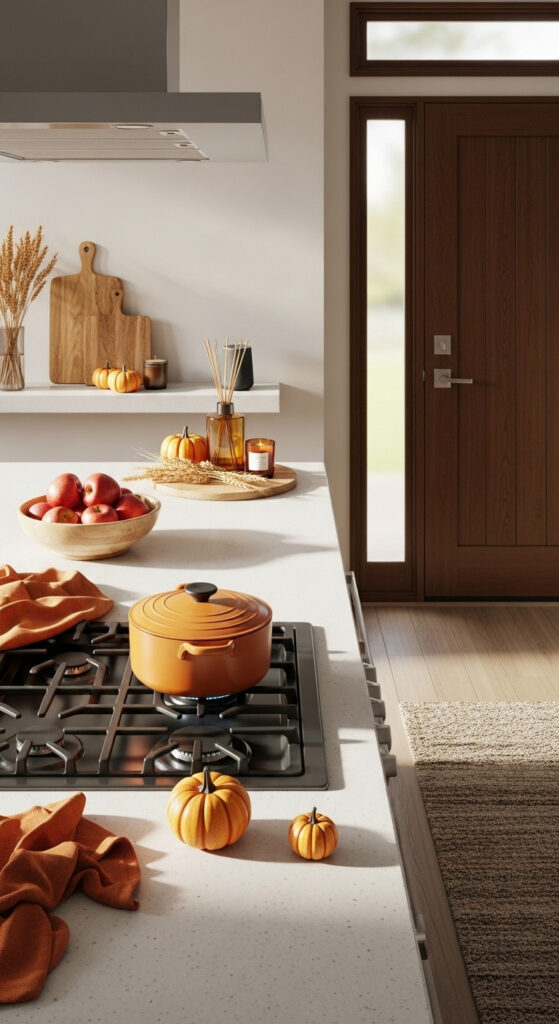
Décor is visual, but atmosphere is multi-sensory. Keep scent subtle and food-adjacent: a small simmer pot of apple peels, cloves, and orange on the back burner, or a reed diffuser with cedar or vanilla in the entry. For sound, make a single playlist that leans acoustic and keeps volume low enough for easy conversation. Little details like these don’t photograph, but they define how the day feels and make the whole home seem thoughtfully pulled together.
Meet Tomas Clayton, a seasoned plant gardener who has been passionate about horticulture since he was a child. Tomas John developed a love for the natural world and a strong appreciation for the beauty of plants while growing up on a farm.

